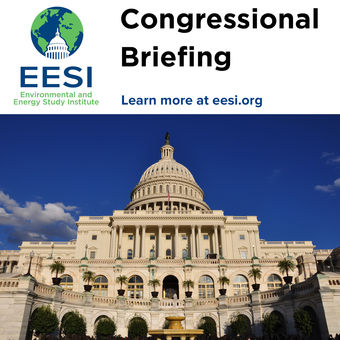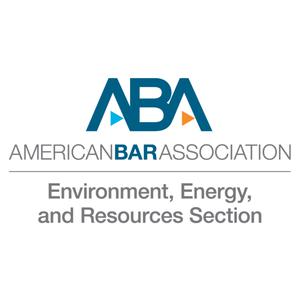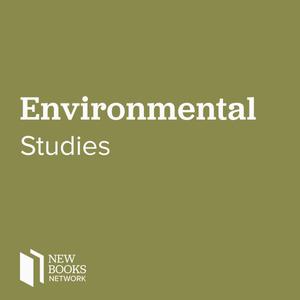
Environmental and Energy Study Institute (EESI)
Environmental and Energy Study Institute (EESI)
EESI is best known for its non-partisan Congressional briefings on key energy and environmental issues. Topics include climate change, renewable energy, and energy efficiency. Learn more at www.eesi.org/briefings http://www.eesi.org/briefings.
- 1 hour 29 minutesNavigating Climate Information for Effective Policy-Making
Ready to make a difference in climate policy, but not sure where to start? We have you covered. The Environmental and Energy Study Institute (EESI) invites you to view our start-of-the-new-Congress briefing series, Climate Camp. We review climate science, cutting-edge innovations, and the role of the legislative process in climate mitigation and adaptation.
EESI’s first Climate Camp briefing served as an interactive refresher on the drivers of climate change and the latest deployable solutions to address the challenge. This Congress, topics such as agriculture, infrastructure, and national security will be front and center. The briefing covered climate concepts and terminology—from types of greenhouse gases to renewable energy technologies—to help you identify policy solutions at the intersection of these issue areas.
At this briefing, panelists showcased tools—like the EN-ROADS simulator, co-developed by MIT Sloan and Climate Interactive—that staff can use to easily digest climate data and generate policy ideas. They also highlighted federal agency resources essential to understanding the climate challenge and innovative solutions to address it.
31 January 2025, 4:31 pm - 1 hour 32 minutesThe Columbia River
The Environmental and Energy Study Institute (EESI) held a briefing about climate adaptation, resilience, and mitigation strategies in the Columbia River basin. The Columbia, which winds through British Columbia, Oregon, and Washington state, is an important source of food, drinking water, irrigation, recreation, and clean energy for the Pacific Northwest. However, the effects of climate change have created and exacerbated problems like estuarine habitat loss, toxic algal blooms, low water levels, and diminished fish populations, highlighting the importance of finding science-based solutions to these issues.
This briefing also discussed the outcomes of the Uncommon Dialogue, which brought together tribes, national and local government, the hydropower industry, and river conservation stakeholders to identify shared approaches to steward river health and safety while ensuring hydropower operations provide clean, affordable energy. Panelists discussed the role of federal investments in the Columbia River’s resilience and health, including Inflation Reduction Act and Infrastructure Investment and Jobs Act funding.
31 January 2025, 4:21 pm - 1 hour 30 minutesThe Tennessee River | Resilient and Healthy River Communities Series
The Environmental and Energy Study Institute (EESI) held a briefing about strategies to improve biodiversity and river health along the Tennessee River, which winds through Tennessee, Alabama, Mississippi, and Kentucky. The Tennessee River, one of the most biodiverse rivers in North America, experiences damaging issues ranging from PFAS and plastics to chemical pollution from landfills and manufacturing. These issues threaten both water quality and the health and well-being of the many communities in the river’s watershed.
This briefing highlighted the importance of effective enforcement of local, state, and federal clean water laws and regulations. Panelists discussed the role of federal policy-making in boosting river health, as well as opportunities to support biodiversity.
13 December 2024, 4:34 pm - 59 minutes 38 secondsU.S.-China Engagement and International Climate Diplomacy
The Environmental and Energy Study Institute (EESI) held a briefing about the role of United States-China climate engagement in shaping the progress and outcomes of international climate governance. From critical mineral supply chains to clean energy and transportation technology, dynamics between the two countries are complex and sometimes fraught. This briefing explored how the countries’ relations across broader climate and environmental issues have influenced and will continue to influence the annual U.N. climate change negotiations.
In 2023, the United States and China produced the Sunnylands Statement ahead of the U.N. climate change negotiations (COP28), following a tradition of publishing similar joint positions in prior years. The statement covered topics related to the energy transition, forest conservation, and non-CO2 greenhouse gas emissions, including methane. It also kicked off a working group focused on “climate action in the 2020s,” which started meeting in the first half of 2024.
During the briefing, panelists explained how these bilateral interactions play into the international negotiations on climate change, outlined what to expect during COP29 and its lead up, and discussed the effectiveness of diplomatic efforts in curbing greenhouse gas emissions.
29 October 2024, 6:21 pm - 1 hour 3 minutesMethane Mitigation on the Global Stage
The Environmental and Energy Study Institute (EESI) held a briefing discussing how nations can collaborate to monitor and mitigate methane emissions to improve air quality and meet emission reduction targets. Methane accounts for 30% of the rise in global temperatures since the Industrial Revolution and has 80 times the warming potential of carbon dioxide, making it a key lever in addressing the climate crisis.
Ahead of the United Nations annual conference on climate change (COP29), this briefing covered policies nations are implementing to effectively reduce their domestic methane emissions in the energy, agriculture, and waste sectors. Panelists discussed the implementation of the Global Methane Pledge, which 155 countries have signed, and highlighted the role of technology in improving methane monitoring, compliance, and reduction.
29 October 2024, 6:17 pm - 59 minutes 3 secondsWhat’s on the Table for the Negotiations
The Environmental and Energy Study Institute (EESI) held a briefing about what Congress can expect during the upcoming United Nations climate negotiations in Baku, Azerbaijan (COP29). From the opening World Climate Action Summit to the intense negotiations of the conference’s final days, thousands of events will take place over the course of the two-week U.N. session. Whether traveling to Baku or observing COP29 from D.C., this briefing will guide policymakers on how to engage effectively.
Panelists previewed key issues on the negotiating agenda, from setting the new global climate finance goal and determining metrics for climate adaptation to updating national climate goals. The briefing also unpacked the complex process of international climate negotiations, reviewed possible policy outcomes, and explored pathways for subsequent Congressional action.
24 October 2024, 2:43 pm - 1 hour 40 minutesThe Mississippi River
The Environmental and Energy Study Institute (EESI) held a briefing that examined the environmental challenges facing the Mississippi River and solutions to address them. Spanning 10 states, the Mississippi plays a key role in tourism, commerce, biodiversity, and recreation in the United States. In particular, the river system moves hundreds of millions of tons of freight each year, serves as a home to hundreds of different fish, mammal, and amphibian species, and supports 1.3 million jobs. However, like many other river systems featured in this briefing series, the Mississippi River and the communities that depend on it face challenges such as nitrate pollution, saltwater intrusion, flooding, and low water levels—many of which are exacerbated by climate change. At this briefing, Mississippi River experts discussed the role of federal policy in advancing strategies to improve both the health and climate resilience of the river system.
15 October 2024, 3:02 am - 1 hour 31 minutesFunding Opportunities for Nonprofits, Municipalities, and Communities
The Environmental and Energy Study Institute (EESI) held a briefing that explored the Inflation Reduction Act (IRA) and Infrastructure Investment and Jobs Act (IIJA) funding dedicated to nonprofit organizations and municipalities. For example, the introduction of “direct pay” is allowing tax-exempt entities to access the benefits of federal tax credits for the first time. Meanwhile, the Department of Energy and the Environmental Protection Agency are hard at work rolling out new programs specifically tailored to these entities. The IRA and IIJA are opening new doors for nonprofits and local governments working to reduce greenhouse gas emissions and adapt to a changing climate.
These opportunities also bring questions: What capacities do varying organizations and municipalities have to apply for, manage, and monitor funding? What reporting requirements could pose challenges for grantees? What does equity look like across these different programs?
Panelists addressed these questions and described the status of IRA and IIJA programs that increase the technical and financial capacity of public sector groups. They also shared case studies from across the country where funding is making a difference in communities, and discussed what lessons can be learned to bolster these federal efforts going forward.
3 October 2024, 7:30 pm - 1 hour 34 minutesExploring the Policy Landscape of Carbon Dioxide Removal
More information at: https://www.eesi.org/091224cdr
The Environmental and Energy Study Institute (EESI) and the World Resources Institute (WRI) held a briefing about effective policy-making for carbon dioxide removal (CDR). CDR—the practice of removing and storing carbon dioxide from the atmosphere and ocean—comes in many forms, including direct air capture, soil carbon sequestration, ocean CDR, and forest restoration. These methods have garnered increasing scientific, governmental, and private sector interest, but expanded policy development is needed to bring them to the scale needed to meet national climate goals. Leveraging key findings from recent reports, panelists from NGOs, academia, and the private sector explored existing policies supporting different stages of CDR development, the level of CDR we expect to need, the potential for CDR in the United States, policy options to enable scaling to that level, and private sector perspectives on the policy landscape. Panelists also pinpointed key takeaways relevant for federal policymakers. TABLE OF CONTENTS: 00:00 - Start 02:28 - Senator Michael Bennet, U.S. Senator (D-Colo.) 27:44 - Katie Lebling, Associate II, Carbon Removal, World Resources Institute (WRI) 38:48 - Galen Bower, Senior Analyst, Rhodium Group 47:47 - Peter Psarras, Research Assistant Professor, University of Pennsylvania 59:21 - Laura Hatalsky, Deputy Director of Policy, Carbon Removal Alliance 01:10:55 - Q&A
19 September 2024, 3:45 pm - 1 hour 32 minutesMaximizing the Impact of Natural Climate Solutions
The Environmental and Energy Study Institute (EESI), U.S. Nature4Climate, and the Bipartisan Policy Center held a briefing on natural climate solutions, which leverage natural processes—like those in forests, grasslands, soils, and wetlands—to reduce carbon emissions, sequester carbon, and bring new income and employment opportunities to rural America. Natural climate solutions as a whole are a widely popular strategy to address climate change, with 92% of people across the political spectrum in support of their implementation.
This briefing explored the federal role in maximizing the benefits of natural climate solutions. The panel convened experts studying natural climate solutions and practitioners implementing programs supported by federal agencies. These panelists discussed what is working, what we are still learning, and what the next phase of natural climate solutions policy and implementation looks like to support the long-term productivity and resilience of America’s natural and working lands and the prosperity of rural communities.
12 June 2024, 9:29 pm - 1 hour 30 minutesCities Leading the Way on Nature-Based Solutions
The Environmental and Energy Study Institute (EESI) held a briefing about climate solutions from small- and medium-sized cities. Cities around the country are taking steps to reduce greenhouse gas emissions and adapt to a changing climate. Many cities and community partners are doing this work with support from federal agencies, while others can share key learnings from project implementation to help inform federal decision-making.
During this briefing, speakers focused on nature-based solutions in cities—from parks that help manage stormwater to urban trees that can reduce summer temperatures across entire neighborhoods. Panelists, including city government officials, community leaders, and federal agency partners, highlighted equitable and community-designed climate solutions from the places they live and work and described the intersection points with federal policy and programs.
24 May 2024, 6:29 pm - More Episodes? Get the App
- http://www.eesi.org/
- English
Your feedback is valuable to us. Should you encounter any bugs, glitches, lack of functionality or other problems, please email us on [email protected] or join Moon.FM Telegram Group where you can talk directly to the dev team who are happy to answer any queries.
 Environment, Energy, and Resources Section
Environment, Energy, and Resources Section
 Insider Podcast
Insider Podcast
 Environmental Change Institute
Environmental Change Institute
 New Books in Environmental Studies
New Books in Environmental Studies
 The Global Energy & Environmental Law Podcast
The Global Energy & Environmental Law Podcast